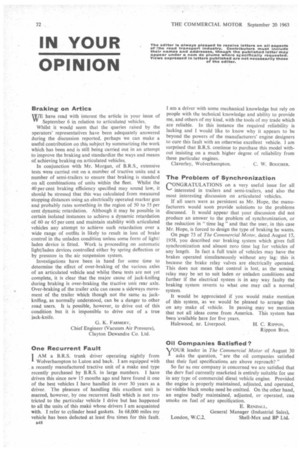IN YOUR OPINION
Page 74

If you've noticed an error in this article please click here to report it so we can fix it.
Braking on Artics WE have read with interest the article in your issue of September 6 in relation to articulated vehicles. Whilst it would seem that the queries raised by the operators' representatives have been adequately answered during the discussion reported, perhaps we can make a useful contribution on this subject by summarizing the work which has been and is still being carried out in an attempt to improve the braking and standardize the ways and means of achieving braking on articulated vehicles.
In conjunction with Mr. Morgan, of B.R.S., extensive tests were carried out on a number of tractive units and a number of semi-trailers to ensure that braking is standard on all combinations of units within the fleet. Whilst the 40 per cent braking efficiency specified may sound low, it should be stressed that this was calculated from measured stopping distances using an electrically operated marker gun and probably rates something in the region of 50 to 55 per cent dynamic retardation. Although it may be possible in certain isolated instances to achieve a dynamic retardation of 60 or 65 per cent and maintain stability with articulated vehicles any attempt to achieve such retardation over a wide range of outfits is likely to result in loss of brake control in the unladen condition unless some form of light/ laden device is fitted. Work is proceeding on automatic light/laden devices controlled either by spring deflection or by pressure in the air suspension system.
Investigations have been in hand for some time to determine the effect of over-braking of the various axles of an articulated vehicle and whilst these tests are not yet complete, it is clear that the major cause of jack-knifing during braking is over-braking the tractive unit rear axle. Over-braking of the trailer axle can cause a sideways movement of the trailer which though not the same as jackknifing, as normally understood, can be a danger to other road users. It is possible, however, to drive out of this condition but it is impossible to drive out of a true jack-knife.
G. K. FARMERY,
Chief Engineer (Vacuum Air Pressure), Clayton Dewandre Co. Ltd.
One Recurrent Fault I AM a B.R.S. trunk driver operating nightly from Wolverhampton to Luton and back. I am equipped with a recently manufactured tractive unit of a make and type recently purchased by B.R.S. in large numbers. I have driven this since new 15 months ago and have found it one of the best vehicles I have handled in over 30 years as a driver. The pleasure of handling this excellent unit is marred, however, by one recurrent fault which is not restricted to the particular vehicle I drive but has happened to all the units of this make whose drivers I am acquainted with. I refer to cylinder head gaskets. In 68,000 miles my vehicle has been defected at least five times for this fault.
ailft I am a driver with some mechanical knowledge but rely on people with the technical knowledge and ability to provide me, and others of my kind, with the tools of my trade which are reliable. In this instance the required reliability is lacking and I would like to know why it appears to be beyond the powers of the manufacturers' engine designers to cure this fault with an otherwise excellent vehicle. I am surprised that B.R.S. continue to purchase this model without insisting on a much higher degree of reliability from these particular engines.
Claverley, Wolverhampton. C. W, BOUCHER, The Problem of Synchronization CONGRATULATIONS on a very useful issue for all interested in trailers and semi-trailers, and also the most interesting discussion on articulated vehicles.
If all users were as persistent as Mr. Hope, the manufacturers would soon provide solutions to the problems discussed. It would appear that your discussion did not produce an answer to the problem of synchronization, or the reduction in "time lag" and that the user, in this case Mr. Hope, is forced to design the type of braking he wants.
On page 73 of The Commercial Motor, dated August 15, 1958, you described our braking system which gives full synchronization and almost zero time lag for vehicles of any length. In fact a full train of vehicles may have the brakes operated simultaneously without any lag: this is because the brake relay valves are electrically operated. This does not mean that control is lost, as the sensing relay may be set to suit laden or unladen conditions and further if the electrical system is in any way faulty the braking system reverts to what one may call a normal. system.
It would be appreciated if you would make mention of this system, as we would be pleased to arrange this on any make of vehicle. In passing may we mention that not all ideas come from America. This system has been 'available here for five years.
Halewood, nr.. Liverpool. H. C. RIPPON, R ippon Bros.
Oil Companies Satisfied?
'TOUR leader in The Commercial Motor of August 30 I asks the question, "are the oil companies satisfied that their fnel specifications are above reproach?" So far as our company is concerned we are satisfied that the dery fuel currently marketed is entirely suitable for use in any type of commercial diesel vehicle engine. Provided the engine is properly maintained, adjusted, and operated, no visible black smoke need be emitted. On the other hand, an engine badly maintained, adjusted, or operated, can smoke on fuel of any specification.
E. RENDAI.L,
General Manager (Industrial Sales), London, W.C.2. Shell-Me x and BP Ltd.




















































































































